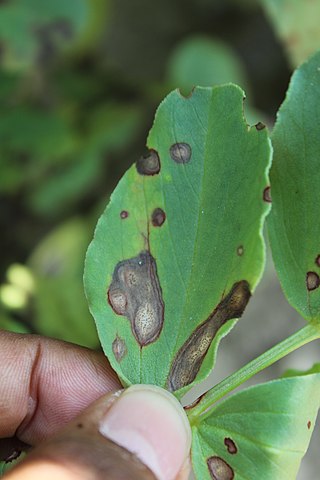Blight refers to a specific symptom affecting plants in response to infection by a pathogenic organism.
Ascochyta medicaginicola is a plant pathogen infecting alfalfa and Medicago truncatula. One particular disease is spring black stem.
Ascochyta tarda or Phoma tarda is a fungal plant pathogen that causes dieback and leafspot on coffee and was first observed in Ethiopia in 1954. It poses a potentially serious threat to coffee crops, but climate change may reduce the prevalence of environmental conditions favorable to its spread.
Ascochyta tritici is a fungal plant pathogen that causes Ascochyta leaf spot on barley, wheat and maize.

Ascochyta is a genus of ascomycete fungi, containing several species that are pathogenic to plants, particularly cereal crops. The taxonomy of this genus is still incomplete. The genus was first described in 1830 by Marie-Anne Libert, who regarded the spores as minute asci and the cell contents as spherical spores. Numerous revisions to the members of the genus and its description were made for the next several years. Species that are plant pathogenic on cereals include, A. hordei, A. graminea, A. sorghi, A. tritici. Symptoms are usually elliptical spots that are initially chlorotic and later become a necrotic brown. Management includes fungicide applications and sanitation of diseased plant tissue debris.

Didymella pinodes is a hemibiotrophic fungal plant pathogen and the causal agent of ascochyta blight on pea plants. It is infective on several species such as Lathyrus sativus, Lupinus albus, Medicago spp., Trifolium spp., Vicia sativa, and Vicia articulata, and is thus defined as broadrange pathogen.

Didymella rabiei, commonly called chickpea ascochyta blight fungus, is a fungal plant pathogen of chickpea. Didymella rabiei is the teleomorph of Ascochyta rabiei, which is the anamorph, but both names are the same species.
Ascochyta asparagina is a fungal plant pathogen. It causes stem blight of asparagus, causing loss or death of branches.
Stagonosporopsis trachelii is a fungal plant pathogen that causes Ascochyta leaf spot in Campanula species.
Ascochyta fabae f.sp. lentis is a plant pathogen that causes ascochyta blight on lentil.

Ascochyta pisi is a fungal plant pathogen that causes ascochyta blight on pea, causing lesions of stems, leaves, and pods. These same symptoms can also be caused by Ascochyta pinodes, and the two fungi are not easily distinguishable.

Ascochyta sorghi is a fungal plant pathogen. It causes Ascochyta leaf spot on barley that can also be caused by the related fungi Ascochyta hordei, Ascochyta graminea and Ascochyta tritici. It is considered a minor disease of barley.
Ascochyta spinaciae is a fungal plant pathogen that causes leaf spot of spinach.
Ascochyta doronici is a fungal plant pathogen that causes leaf spot on African daisy.

Ascochyta fabae is a plant pathogen.
Ascochyta graminea is a plant pathogen that causes Ascochyta leaf spot on barley which can also be caused by the related fungi Ascochyta hordei, Ascochyta sorghi and Ascochyta tritici. It is considered a minor disease of barley.

The Pleosporales is the largest order in the fungal class Dothideomycetes. By a 2008 estimate, it contained 23 families, 332 genera and more than 4700 species. The majority of species are saprobes on decaying plant material in fresh water, marine, or terrestrial environments, but several species are also associated with living plants as parasites, epiphytes or endophytes. The best studied species cause plant diseases on important agricultural crops e.g. Cochliobolus heterostrophus, causing southern corn leaf blight on maize, Phaeosphaeria nodorum causing glume blotch on wheat and Leptosphaeria maculans causing a stem canker on cabbage crops (Brassica). Some species of Pleosporales occur on animal dung, and a small number occur as lichens and rock-inhabiting fungi.
Calophoma clematidina is a fungal plant pathogen and the most common cause of the disease clematis wilt affecting large-flowered varieties of Clematis. Symptoms of infection include leaf spotting, wilting of leaves, stems or the whole plant and internal blackening of the stem, often at soil level. Infected plants growing in containers may also develop root rot.

Ascochyta blights occur throughout the world and can be of significant economic importance. Three fungi contribute to the ascochyta blight disease complex of pea. Ascochyta pinodes causes Mycosphaerella blight. Ascochyta pinodella causes Ascochyta foot rot, and Ascochyta pisi causes Ascochyta blight and pod spot. Of the three fungi, Ascochyta pinodes is of the most importance. These diseases are conducive under wet and humid conditions and can cause a yield loss of up to fifty percent if left uncontrolled. The best method to control ascochyta blights of pea is to reduce the amount of primary inoculum through sanitation, crop-rotation, and altering the sowing date. Other methods—chemical control, biological control, and development of resistant varieties—may also be used to effectively control ascochyta diseases.






